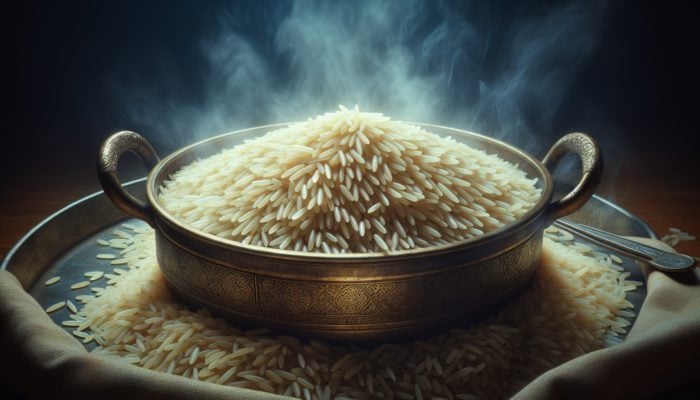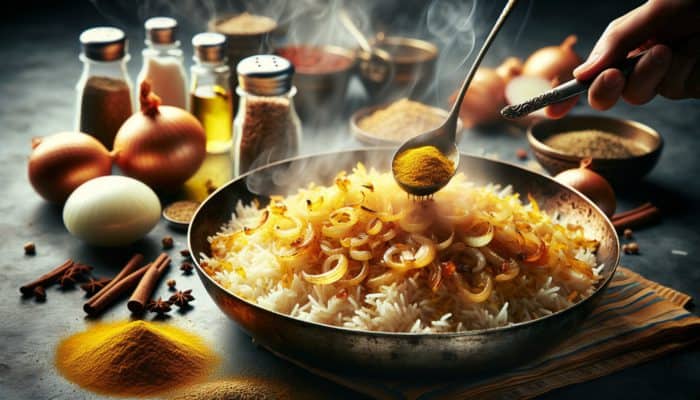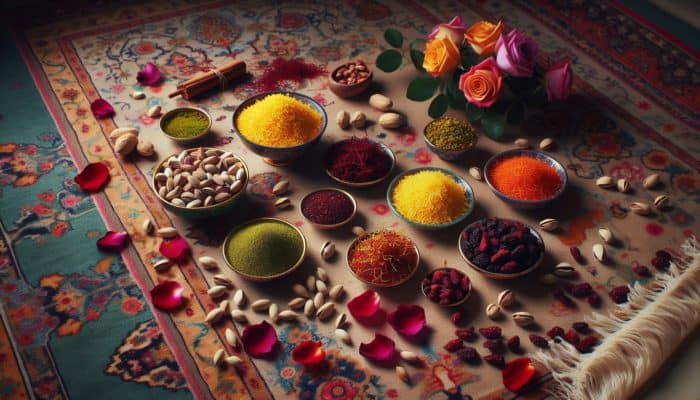Essential Ingredients for Authentic Iranian Pilaf
Choosing the Perfect Rice for Pilaf

How to Cook a Fragrant Iranian Pilaf: Selecting the ideal rice is fundamental for achieving the perfect texture and enticing aroma in your pilaf. For a genuine how to cook a fragrant Iranian pilaf, opting for high-quality long-grain rice varieties, particularly Basmati, is essential. Renowned for its nutty flavour and fluffy texture, Basmati rice features long, slender grains that are highly aromatic, making them perfect for soaking up flavours without turning mushy. When choosing your rice, it’s advisable to buy from reputable brands that guarantee quality and purity, as the rice's quality can greatly influence the overall success of the dish.
The initial step in preparing the rice involves rinsing it thoroughly under cold water. This crucial process eliminates excess starch, which can lead to clumping during cooking. It’s important to rinse the rice until the water runs clear, signalling that the grains are free from impurities. Following rinsing, soaking the rice for a minimum of 30 minutes is recommended, as this not only enhances the texture but also significantly reduces the cooking time. Soaking allows the rice to absorb water, ensuring even cooking, which is vital for mastering the art of crafting the perfect pilaf.
Additionally, consider experimenting with various rice blends or incorporating multi-grain options to elevate the nutritional value of your fragrant Iranian pilaf. Adding whole grains such as quinoa or barley can create a delightful twist while boosting the health benefits of the dish. Ultimately, selecting the right rice not only lays the groundwork for an exceptional pilaf but also allows it to take centre stage as the highlight of your meal.
Crafting the Ideal Spice and Herb Blend
The essence of a fragrant Iranian pilaf resides in its carefully selected spices and herbs. A well-balanced combination of flavours transforms a simple rice dish into a culinary masterpiece. Traditional Iranian cuisine often incorporates spices such as cumin, turmeric, and cinnamon, each contributing its distinct character to the dish. The warm, earthy tones of cumin blend harmoniously with the subtle sweetness of cinnamon, while turmeric adds a vibrant colour and notable health benefits. To maximise their potential, toasting these spices before cooking is essential, as it releases their essential oils, enhancing both their aromas and flavours.
Fresh herbs play an equally important role in creating a captivating aromatic profile. Commonly used herbs in Iranian pilafs include dill, mint, and parsley, each offering a refreshing burst of flavour. Dill, in particular, provides a distinctive taste that pairs exceptionally well with rice, while mint adds a refreshing note that brightens the entire dish. When using fresh herbs, chop them finely and incorporate them towards the end of the cooking process to retain their vibrant colour and flavour.
Don’t hesitate to explore less conventional spices. For instance, saffron represents a luxurious addition that imparts a unique taste and an exquisite golden hue to the pilaf. Infusing this spice in a small amount of warm water before adding it to the dish ensures that its delicate qualities are preserved during the cooking process. Ultimately, the meticulous selection and balance of spices and herbs will define how to cook a fragrant Iranian pilaf, creating a symphony of flavours that can transport you straight to the heart of Iran.
Enhancing Your Pilaf with Additional Ingredients
Elevating your Iranian pilaf with supplementary ingredients can significantly enhance its flavour profile and nutritional content. Traditional components, such as nuts and dried fruits, add not only texture but also a delightful contrast to the savoury elements of the dish. Popular choices include almonds, pistachios, and walnuts, which provide a satisfying crunch. Lightly toasting these nuts before incorporating them into the pilaf amplifies their nutty aroma and deepens their flavour, making them a standout feature of the dish.
Dried fruits such as barberries, raisins, and apricots are excellent additions, offering a sweet tartness that beautifully balances the savoury spices. Barberries, in particular, hold a special place in Persian cuisine; their bright red colour and tangy flavour impart a unique touch to the dish. When adding these fruits, it’s advisable to soak them briefly in warm water to plump them up before mixing them into the pilaf, ensuring they blend seamlessly with the rice.
If you're aiming to introduce protein into your Iranian pilaf, consider incorporating meats such as chicken or lamb. These proteins can be marinated with spices before cooking, allowing their flavours to infuse the dish. Alternatively, for a vegetarian option, chickpeas or lentils can be used, providing both protein and substance to the meal. Careful layering of these additional ingredients during the cooking process ensures that each element cooks evenly, allowing the flavours to meld beautifully in your how to cook a fragrant Iranian pilaf.
Mastering Preparation Techniques for Perfect Pilaf

Soaking the Rice for Optimal Texture
Soaking rice is a crucial step in preparing the perfect Iranian pilaf, as it significantly impacts both texture and cooking time. This process involves immersing the grains in water for a specific duration before cooking, typically ranging from 30 minutes to several hours. This step is particularly crucial for varieties like Basmati rice, known for its long grains and delicate flavour. Soaking allows the rice to absorb water, which softens the grains and reduces the likelihood of breakage during cooking.
By soaking the rice, you also shorten the cooking time, as the grains have already taken in moisture. This ensures that they cook evenly and become fluffy, rather than sticky or mushy. For those wondering about the optimal soaking duration, a minimum of 30 minutes is recommended, but soaking for up to two hours can yield even better results. Some culinary enthusiasts advocate soaking overnight for the perfect rice, although this often depends on personal preference and the specific recipe being followed.
Moreover, consider seasoning the soaking water with a pinch of salt or even infusing it with spices to enhance the flavour profile of the rice before it enters the pot. This initial step lays the groundwork for a beautifully aromatic pilaf and is essential for those looking to master the art of cooking a fragrant Iranian pilaf.
Unlocking Flavours by Toasting Spices
Toasting spices is a fundamental culinary technique that unlocks the full potential of flavours in your Iranian pilaf. This straightforward yet impactful method enhances both the aroma and taste of spices, transforming them into bold, fragrant elements of the dish. Begin by selecting your preferred spices, such as cumin, turmeric, and cinnamon, and place them in a dry pan over low to medium heat.
As you toast the spices, keep a vigilant eye on them; they can easily burn and become bitter if left unattended. Stirring frequently will help ensure even toasting. The process typically takes a few minutes, during which you'll notice the spices darkening slightly and releasing their essential oils, filling your kitchen with an irresistible aroma. Once they become fragrant, promptly remove them from the heat to prevent over-roasting.
Incorporating these toasted spices into your pilaf at the right moment is crucial for optimal flavour. For best results, add them at the beginning of the cooking process, allowing them to infuse into the oil used for sautéing onions or other aromatics. This technique ensures that the spices permeate every grain of rice, resulting in a well-rounded taste throughout. Toasting spices is an essential step in achieving a perfectly flavoured and fragrant Iranian pilaf, enriching the dish with warmth and depth.
Layering Techniques for Enhanced Flavour

Layering is a technique that plays a vital role in achieving a well-cooked and flavourful Iranian pilaf. Unlike basic rice cooking methods that may involve simply mixing all ingredients, layering allows for better heat distribution and flavour integration. Begin by sautéing your aromatics, such as onions, in oil or butter until they become golden and fragrant. This foundational layer of flavour is essential, as it forms the base of your pilaf.
Once your aromatics are ready, it’s time to introduce the spices. Sprinkle them over the onions and stir for a minute to release their fragrances. Following this, add the soaked rice, allowing it to coat in the aromatic mixture. For even distribution, use a spatula to gently fluff the rice instead of stirring vigorously, which could break the grains.
One effective layering method is the ‘dough lid’ technique. By placing a layer of dough around the pot's rim, you can create a seal that traps steam within, promoting even cooking. Alternatively, using a clean kitchen towel placed over the rice before covering the pot with a lid serves a similar purpose. This ensures that each grain of rice cooks evenly and absorbs the delightful flavours from the lower layers of the dish. Mastering the art of layering is crucial for learning how to cook a fragrant Iranian pilaf that is both visually stunning and flavour-packed.
Exploring Diverse Cooking Methods
Traditional Stovetop Cooking Techniques
Stovetop cooking remains the traditional method for preparing Iranian pilaf, providing complete control over the cooking process. Begin by preparing your ingredients, including the soaked rice, spices, and any additional components. Initially, heat a generous amount of oil or butter in a heavy-bottomed pot over medium heat. Once the oil is hot, add your sautéed onions, allowing them to caramelise slightly before introducing the spices.
Next, gently fold in the soaked rice, ensuring it is well-coated with the mixture of spices and onions. At this stage, it's crucial to add the correct amount of water or broth—typically, a 1:2 ratio of rice to liquid. Bringing the mixture to a boil is essential for initiating the cooking process. Once it reaches a rolling boil, reduce the heat to low and cover the pot with a tight-fitting lid.
Allowing the rice to simmer gently for 20-30 minutes enables it to absorb the liquid fully. Avoid lifting the lid during this time, as the steam created is vital for cooking the rice evenly. Once the cooking time is complete, it’s advisable to let the pilaf rest off the heat for an additional 10 minutes. This resting period helps evenly distribute any remaining moisture throughout the rice, enhancing its fluffy texture. This classic stovetop method is fundamental for mastering how to cook a fragrant Iranian pilaf with rich flavours and gratifying aromas.
Oven Baking for Perfect Tahdig
Oven baking offers a fantastic alternative to stovetop cooking, especially for those craving a crispy tahdig, the prized layer of crisp rice that forms at the bottom of the pot. To start, preheat your oven to 180°C (350°F). Follow the initial steps of sautéing your onions and toasting your spices, then mix in the soaked rice as before. However, instead of cooking on the stovetop, transfer the mixture to a suitable ovenproof dish.
Add the appropriate amount of water or broth to your rice mixture, ensuring the grains are fully submerged. Cover the dish with a tight-fitting lid or foil to trap steam during the baking process. Placing the dish in the preheated oven allows the rice to cook evenly while the bottom layer develops that coveted crispy tahdig. Bake for approximately 45-60 minutes, or until the rice is tender and the liquid has been fully absorbed.
To achieve an even crispier tahdig, consider removing the lid during the final 10-15 minutes of baking. This allows the bottom layer to crisp up beautifully, adding a delightful crunch that contrasts with the fluffy rice above. Once baked, let the pilaf rest briefly before serving, allowing the flavours to meld. Oven baking is an enjoyable way to master the art of cooking a fragrant Iranian pilaf, allowing the richness of the ingredients to shine while providing an impressive presentation.
Convenience of Slow Cooking
The slow cooker provides a convenient, hands-off approach to preparing Iranian pilaf, making it an excellent option for busy weeknights or gatherings. To begin, gather your ingredients and prepare them as you would for traditional methods. Sauté the onions and spices in a skillet, then transfer this mixture to the slow cooker. Next, add the soaked rice along with the necessary water or broth, ensuring all ingredients are well combined.
Set the slow cooker to the appropriate setting—low or high, depending on your available time. Cooking on low for approximately 4-6 hours allows for a gradual infusion of flavours, while a high setting should yield tender rice in about 2-3 hours. One added advantage of using a slow cooker is the ability to incorporate proteins like chicken or lamb from the outset, allowing them to tenderise as they cook alongside the rice.
An important consideration when using a slow cooker is to adjust the liquid accordingly, as these appliances retain moisture more effectively than traditional cooking methods. It's wise to monitor the dish as it cooks, checking for doneness as the cooking time approaches its end. The convenience and ease of a slow cooker make it an appealing option for learning how to cook a fragrant Iranian pilaf, allowing you to focus on other tasks while the dish comes together beautifully.
Utilising the Pressure Cooker for Quick Results
For those seeking a quick and efficient method to prepare Iranian pilaf, the pressure cooker is a real game-changer. This technique significantly reduces cooking times while ensuring the rice remains fluffy and flavourful. Begin by preparing your ingredients as you would for other methods. Sauté your onions, toast your spices, and add the soaked rice to the pot.
The key to effectively using a pressure cooker is the right liquid ratio. Typically, a 1:1.5 ratio of rice to water is ideal, as the pressure cooker requires less liquid than stovetop cooking. After adding the liquid, secure the lid tightly and set the pressure cooker to high. Cooking times will vary depending on your specific cooker, but it typically takes 7-10 minutes for the rice to cook thoroughly.
Once the cooking cycle is complete, allow the pressure to release naturally for optimal results. This step allows any residual steam to finish cooking the rice gently. Carefully remove the lid and fluff the pilaf with a fork before serving, ensuring that each grain is separate and infused with flavour. The pressure cooker method offers a practical solution for those seeking to master the art of cooking a fragrant Iranian pilaf without dedicating extensive time in the kitchen.
Microwave Cooking for Quick Preparation
For those short on time, microwave cooking offers a swift method for preparing Iranian pilaf without compromising on flavour. Start by combining your soaked rice with the sautéed onions and spices in a microwave-safe bowl. It’s essential to use a bowl large enough to accommodate the rice as it expands during cooking. Add the necessary liquid, ensuring it covers the rice adequately.
Loosely cover the bowl with a microwave-safe lid or plate, allowing steam to escape during cooking. Microwave on high for approximately 10-15 minutes, checking for doneness and adjusting the time as needed. Stirring halfway through can help ensure even cooking and prevent any sticking.
While the microwave method may not deliver the same depth of flavour as traditional techniques, it can serve as a convenient solution for quick meals. Consider enhancing the dish with fresh herbs or toppings after microwaving to introduce a burst of freshness. The microwave method is an invaluable technique for mastering the art of cooking a fragrant Iranian pilaf, particularly for those in need of a rapid yet satisfying meal.
Perfecting the Tahdig Layer
Understanding the Essence of Tahdig
Tahdig, the beloved crispy rice layer at the bottom of an Iranian pilaf, is often considered the crown jewel of the dish. This golden layer is cherished for its delightful crunch and provides a textural contrast to the fluffy rice above. Understanding the significance of tahdig is crucial for anyone seeking to refine their culinary skills in preparing Iranian dishes.
Traditionally, tahdig is created by selecting a cooking method that encourages the rice to develop a crispy crust on the bottom. This can be accomplished through stovetop cooking, oven baking, or even in a pressure cooker, although each method requires careful attention to detail. The process involves using sufficient oil or butter, which not only adds flavour but also helps achieve that coveted crispiness.
The ideal tahdig is golden brown, with a texture that is both crunchy and slightly chewy. Achieving this balance might take practice, but the rewards are certainly worth the effort. Many enthusiasts advocate for using a thin, flat lid or a dough barrier to trap steam and distribute heat evenly, ensuring that the rice cooks perfectly and results in a beautiful layer of tahdig. Understanding the characteristics of tahdig is crucial for mastering the art of cooking a fragrant Iranian pilaf, as it encapsulates the essence of this cherished dish.
Techniques for Crafting Perfect Tahdig
Mastering the art of creating a perfect tahdig requires several essential techniques that every aspiring cook should be familiar with. First, using a non-stick pot or pan is crucial, as this prevents the rice from sticking to the surface and facilitates easy removal of the tahdig once cooked. Begin by heating a generous amount of oil or butter in the pot before adding the rice. This not only aids in crisping but also infuses the rice with a rich flavour.
Another effective technique involves strategically layering the rice. Once the rice is added, gently flatten the surface with a spatula to create an even layer. This ensures that the heat distributes evenly across the rice, promoting uniform cooking. Covering the pot with a tight lid, ideally lined with a kitchen towel to capture steam, creates a steaming effect that helps develop that crispy bottom layer.
Timing is everything—allow the rice to cook for the recommended duration, usually around 20-30 minutes, depending on the cooking method. Towards the end, you can check for doneness by gently peeking under the rice with a spatula. Once golden and crispy, carefully invert the pot onto a serving platter, allowing the tahdig to slide out gracefully. Techniques like these will help ensure that your tahdig is always a highlight of how to cook a fragrant Iranian pilaf.
Troubleshooting Common Tahdig Issues
Even the most seasoned cooks may face challenges when attempting to achieve the perfect tahdig. Common issues include uneven cooking, burnt rice, or a tahdig that won’t release from the pot. Fortunately, practical solutions exist for each of these problems. If the tahdig is burning, it often indicates that the heat is too high. Lowering the heat and allowing the rice to cook slowly can prevent this issue.
When dealing with rice that sticks to the pot, consider the quality of your cooking vessel. Using a non-stick pot is highly recommended; if you’re using a traditional pot, generously layering it with oil can help prevent sticking. Additionally, allowing the rice to rest after cooking can help loosen the tahdig, making it easier to lift out.
If the tahdig appears less crispy than desired, it may require more time or a higher cooking temperature. Gently lifting the lid to check on the rice can provide insights into how much longer it needs to cook. With practice and careful attention to detail, troubleshooting tahdig issues will become second nature, thereby enhancing your overall skills in cooking a fragrant Iranian pilaf.
Exploring Variations of Tahdig
Exploring variations of tahdig can introduce an exciting twist to your Iranian pilaf, allowing for creativity and personalisation. While the traditional tahdig made from rice is beloved, consider experimenting with alternative ingredients to add variety. A popular variation is potato tahdig, where thinly sliced potatoes are layered at the bottom of the pot before adding the rice. This method produces crispy potato slices that provide a unique flavour and texture.
Another creative option involves using bread, such as lavash or pita, to create a crust. Placing a layer of bread beneath the rice not only adds a delightful crunch but also absorbs the pilaf's flavours, making it an irresistible accompaniment. This variation can be particularly appealing for those looking to showcase new textures in their meal presentation.
For the adventurous cook, incorporating vegetables into the tahdig, such as sliced eggplant or zucchini, can provide an exciting depth of flavour. These vegetables can be sautéed lightly before being layered beneath the rice, resulting in a tahdig that is as colourful as it is delicious. Exploring variations of tahdig allows you to express your culinary creativity while mastering the art of cooking a fragrant Iranian pilaf, adding new dimensions to this cherished dish.
Enhancing Flavour Profiles
Infusing Saffron for Luxurious Taste
Incorporating saffron into your Iranian pilaf is a luxurious touch that elevates both the flavour and presentation of the dish. Renowned for its vibrant colour and unique taste, saffron is often dubbed the world’s most expensive spice due to the labour-intensive process of harvesting it. To infuse your pilaf with saffron, begin by steeping the threads in a small amount of warm water or stock. This release of colour and flavour is essential for achieving the beautiful golden hue that saffron is famous for.
Once the saffron is infused, the saffron water can be added to the cooking liquid, ensuring that its distinctive qualities permeate the rice. The subtle floral notes of saffron complement the spices and herbs within the pilaf, creating a well-rounded flavour profile. Beyond its culinary merits, saffron boasts various health benefits, including antioxidant properties, making it a worthy addition to your dish.
When using saffron, it’s crucial to prioritise quality. Seek out high-grade saffron from reputable sources, as this can significantly influence the final dish. Typically, a small pinch is sufficient; a little goes a long way. Mastering the incorporation of saffron is key to understanding how to cook a fragrant Iranian pilaf that dazzles both the palate and the eye.
Enhancing with Rose Water
Rose water is a cherished ingredient in Iranian cuisine, celebrated for its delicate floral aroma and flavour. Adding rose water to your pilaf can create a subtle yet enchanting taste that elevates the dish to new heights. This ingredient works particularly well when paired with saffron, enhancing the overall fragrance of the pilaf.
To effectively incorporate rose water, use it sparingly—a few teaspoons usually suffice, added towards the end of the cooking process. This timing ensures that the aromatic qualities of the rose water remain intact. It’s also wise to avoid excessive use, as too much can overpower the dish. Balancing the floral notes with the savoury elements of the pilaf is essential for achieving a harmonious flavour.
Rose water isn’t solely limited to traditional pilafs; consider using it to flavour accompanying dishes or sauces. Its versatility allows for a creative fusion of flavours that can significantly transform your meal. Exploring the use of rose water is essential for mastering the art of cooking a fragrant Iranian pilaf, infusing your dish with an irresistible and aromatic appeal.
Creating a Sweet and Savoury Harmony
Crafting a delicious Iranian pilaf involves skillfully balancing sweet and savoury elements. The addition of dried fruits, such as raisins, apricots, or barberries, introduces a natural sweetness that beautifully complements the savoury spices. This balance is crucial in creating a well-rounded dish that excites the palate.
When incorporating sweet elements, consider the overall composition of the pilaf. For instance, if using sweet dried fruits, balance their flavours with the richness of toasted nuts or the warmth of spices like cumin and cinnamon. This interplay of flavours can create a symphony that elevates the dish to a gourmet level.
To achieve this balance, add the dried fruits towards the end of the cooking process. This allows them to plump up and integrate into the pilaf without losing their texture. The ultimate goal is to create a dish where the sweet and savoury elements engage in harmonious dialogue, each enhancing the other. Mastering the art of balance is a crucial aspect of learning how to cook a fragrant Iranian pilaf that delights and surprises all who partake.
Exquisite Serving and Presentation Techniques
Artfully Plating Your Pilaf
Plating your Iranian pilaf with care enhances its visual appeal, transforming it into an eye-catching centrepiece for any meal. When serving, consider the dish's colour and texture, opting for a wide, shallow serving platter that showcases the fluffy rice and the golden tahdig. Gently fluff the pilaf with a fork before transferring it to the platter, ensuring that each grain remains separate and fluffy.
Incorporating fresh herbs as a garnish can introduce a vibrant pop of colour and a hint of freshness to the dish. Chopped parsley, mint, or dill can be sprinkled generously over the pilaf, creating a visually appealing contrast against the golden rice. For an added touch, consider using edible flowers, which not only enhance the aesthetic but also introduce a hint of floral notes that can complement the dish's flavours.
To elevate the presentation further, consider serving the pilaf alongside colourful accompaniments, such as a vibrant salad or a tangy yogurt sauce. These additions can add depth and complexity, encouraging guests to explore different flavour combinations. A beautifully plated Iranian pilaf not only demonstrates your culinary skills but also invites enjoyment and appreciation from those at your table, embodying the essence of how to cook a fragrant Iranian pilaf.
Complementary Accompaniments for an Enhanced Dining Experience
Pairing your Iranian pilaf with suitable side dishes and sauces can significantly elevate the overall dining experience. Traditional accompaniments include grilled meats, stews, or a tangy yogurt sauce, which beautifully complement the pilaf's flavours. For a classic pairing, consider serving the pilaf alongside kebabs, marinated and grilled to perfection, creating a harmonious blend of flavours and textures.
A refreshing salad featuring ingredients like cucumbers, tomatoes, and radishes can provide a crisp contrast to the richness of the pilaf. Drizzle it with a lemon vinaigrette to enhance its flavours and cut through the richness of the tahdig. Another popular option is to serve the pilaf with a side of kashk-e bademjan, a delicious eggplant dip that adds depth and complexity to the meal.
For those looking to add a touch of creaminess, a yogurt sauce is an excellent accompaniment. Mixing yogurt with herbs like mint and dill creates a refreshing dip that beautifully balances the savoury notes of the pilaf. These accompaniments are essential in learning how to cook a fragrant Iranian pilaf that delights the senses and creates a well-rounded dining experience.
Storing and Reheating Leftover Pilaf
Properly storing and reheating Iranian pilaf is crucial for maintaining its flavour and texture. If you have leftovers, allow the pilaf to cool to room temperature before transferring it to an airtight container. Proper storage can prolong the dish’s freshness and prevent it from drying out. When stored in the refrigerator, the pilaf can last for up to 3 or 4 days.
When reheating, consider using either the stovetop or microwave method. For stovetop reheating, add a splash of water or broth to the pilaf in a pan, covering it with a lid to create steam. This helps rehydrate the rice and prevents it from becoming dry. Alternatively, if using a microwave, place the pilaf in a microwave-safe dish, add a small amount of water, and cover loosely to allow steam to escape. Heat in short intervals, stirring occasionally, until heated through.
It's advisable to avoid reheating pilaf multiple times, as this can affect its quality and taste. Instead, aim to store and consume the pilaf within a few days for optimal flavour. Mastering the art of storing and reheating is essential for learning how to cook a fragrant Iranian pilaf that remains delicious and enjoyable long after its initial preparation.
Creative Garnishing Techniques for Visual Appeal
Employing innovative garnishing techniques can add flair to your Iranian pilaf, enhancing both its appearance and flavour. While fresh herbs are a classic choice, consider using toasted nuts or seeds to introduce texture and crunch. Sprinkling slivered almonds or pistachios over the top creates an attractive contrast against the fluffy rice, enhancing your dish's visual appeal.
Another option for garnishing is to incorporate pomegranate seeds, which lend a vibrant pop of colour and a refreshing burst of sweetness. These bright seeds can be scattered generously over the pilaf, enhancing aesthetics while also adding a delightful flavour. Edible flowers can also be a lovely touch, particularly for special occasions, creating a stunning presentation that captivates the eye.
For a dramatic finish, consider drizzling a flavoured oil over the pilaf, such as infused olive oil with herbs or spices. This adds a touch of elegance and elevates the overall flavour profile. By incorporating these garnishing techniques, you’ll create a visually appealing and delicious dish that showcases your skills in cooking a fragrant Iranian pilaf and delights everyone at the table.
Frequently Asked Questions about Iranian Pilaf
Which type of rice is ideal for Iranian pilaf?
Basmati rice is the preferred choice for Iranian pilaf due to its long grains, nutty flavour, and aromatic characteristics, which ensure a fluffy and fragrant dish.
Can I prepare Iranian pilaf in a vegetarian version?
Absolutely! You can create vegetarian Iranian pilaf by omitting meat and incorporating chickpeas or lentils for protein, along with a variety of vegetables and spices.
What’s the secret to achieving crispy tahdig?
To achieve crispy tahdig, use a non-stick pot, preheat the oil, layer the rice evenly, cover with a tight-fitting lid, and cook on low heat to allow the bottom layer to crisp perfectly.
Is saffron necessary for Iranian pilaf?
While saffron adds a unique flavour and stunning colour to Iranian pilaf, it’s not strictly necessary. You can still create a delicious dish without it by using other spices.
Can I substitute brown rice for Iranian pilaf?
Yes, brown rice can be used, but it requires a longer cooking time and more liquid than white rice. Adjust your recipe accordingly for the best results.
How should I store leftover pilaf?
Leftover Iranian pilaf should be cooled to room temperature, transferred to an airtight container, and stored in the fridge for up to 3-4 days to maintain freshness.
What are some popular accompaniments for Iranian pilaf?
Common accompaniments include grilled meats, tangy yogurt sauces, fresh salads, or kashk-e bademjan, all of which enhance the overall dining experience beautifully.
Is it possible to prepare Iranian pilaf in advance?
Yes, you can prepare Iranian pilaf ahead of time. Just reheat it thoroughly before serving to ensure it remains delicious and fluffy.
Which spices are essential for Iranian pilaf?
Essential spices for Iranian pilaf include cumin, turmeric, and cinnamon, which create a warm, aromatic flavour profile that defines the dish.
How can I prevent rice from sticking together?
To avoid rice from sticking, rinse it thoroughly before cooking, soak it, and refrain from stirring excessively during cooking to maintain separate grains.



I really appreciate your insights on selecting the right rice for Iranian pilaf. Basmati truly makes a world of difference, not just in flavor but also in texture. I find that the rinsing step is often overlooked, yet it’s so important for achieving that delightful fluffiness.